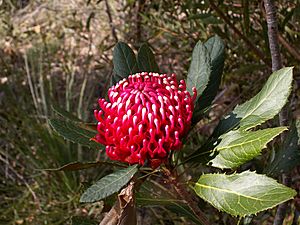Gibraltar Range waratah facts for kids
Quick facts for kids Gibraltar Range waratah |
|
|---|---|
 |
|
| Telopea aspera in the Gibraltar Range National Park. | |
| Scientific classification | |
| Genus: |
Telopea
|
| Species: |
aspera
|
The Telopea aspera, also called the Gibraltar Range waratah, is a beautiful plant. It belongs to the Proteaceae family, which includes many unique Australian plants. This waratah grows as a woody shrub, reaching about 3 metres (10 feet) tall.
It has tough, rough leaves and bright red flower heads. Each flower head is actually made up of hundreds of smaller flowers! You can find this plant only in the New England area of New South Wales, Australia. Scientists Peter Weston and Mike Crisp officially named it in 1995. They noticed it was different from its close relative, Telopea speciosissima, because of its rough leaves and its love for drier places. Unlike its more famous cousin, the Gibraltar Range waratah is not often grown in gardens.
Contents
What Does the Gibraltar Range Waratah Look Like?
The Gibraltar Range waratah is a tall, upright shrub. It can grow up to 3 metres (10 feet) high and often has several stems. Its leaves are a dull green and grow one after another along the stem. They are tougher and have more jagged edges than the leaves of its southern relatives. Each leaf can have 3 to 11 saw-like teeth along its edge.
These leaves are quite large, from 8 to 28 centimetres (3 to 11 inches) long and 2 to 6.5 centimetres (0.8 to 2.5 inches) wide. They feel tough and leathery, and their undersides are a bit furry. You can also see clear veins on both the top and bottom of the leaves.
Flowers and Seeds
In spring, the plant produces large, bright red flower heads. These are shaped like a dome and are surrounded by special leaves called bracts. Each flower head is packed with many individual flowers, usually between 90 and 250 of them!
After the flowers, the plant forms large seed pods. These pods eventually turn brown and split open. Inside, you'll find winged seeds, which help them spread in the wind.
How Scientists Classify the Gibraltar Range Waratah
Telopea aspera is one of five species in the Telopea group. All these species grow in southeastern Australia. Its closest relative is the New South Wales waratah (T. speciosissima). This plant is found near Sydney. For a long time, Telopea aspera was thought to be just a northern version of T. speciosissima.
However, in 1991, scientists realized it was a separate species. It was first called Telopea sp. A. Then, in 1995, it was officially named Telopea aspera. The name aspera comes from a Latin word meaning "rough." This refers to its rough-feeling leaves.
The Telopea group is part of a larger plant family called Proteaceae. This family includes other plants with red flowers, like the tree waratahs from Australia and New Caledonia, and the Chilean firetree from South America. The fact that these similar plants are found on different continents suggests they existed before the supercontinent Gondwana broke apart over 60 million years ago.
Where the Gibraltar Range Waratah Lives
The Gibraltar Range waratah is found only in northern New South Wales, specifically in the Gibraltar Range. It grows in dry sclerophyll forests. These are forests with tough, leathery-leaved plants that can handle dry conditions.
You can find this waratah in three main types of plant communities in the Gibraltar Range:
- One community grows on slopes and hilltops. It includes trees like Gibraltar ash (Eucalyptus olida), privet-leaved stringybark (Eucalyptus ligustrina), and diehard stringybark (Eucalyptus cameronii).
- Another community is found on ridges and slopes facing north and west. Here, it grows with Gibraltar ash, large-fruited blackbutt (Eucalyptus pyrocarpa), and needlebark stringybark (Eucalyptus planchoniana).
Both of these communities grow in thin soil over granite rock.
- The third community is more sheltered, found on lower slopes with sandy or loam soils. Here, it grows with New England blackbutt (Eucalyptus campanulata) and diehard stringybark.
The New South Wales government has listed Telopea aspera as a Rare or Threatened Australian Plant (ROTAP). This means it's a plant that needs protection.
Life Cycle and Survival
The Gibraltar Range waratah has a special way to survive bushfires. It can regrow from a woody base called a lignotuber. This lignotuber stores energy and nutrients. After a fire, the plant uses these stored resources to grow back quickly.
The bright red flowers of waratahs and their relatives in Australia and South America are very noticeable. This suggests that birds help pollinate them. This bird pollination method has likely been happening for over 60 million years!
Growing the Gibraltar Range Waratah
Telopea aspera is not often grown in gardens. Sometimes, people might think they are growing T. speciosissima, but it could actually be this species.
Attempts to grow T. aspera at the Australian Botanic Garden Mount Annan have not been very successful. The plants often die in summer, and scientists are not sure why. However, growing it at Mount Tomah Botanic Gardens has worked better. Its beautiful flowers and leaves make it an attractive plant for gardens.


